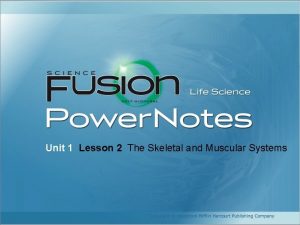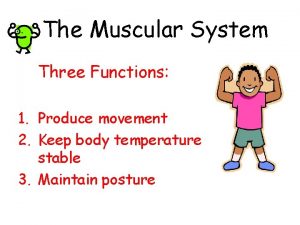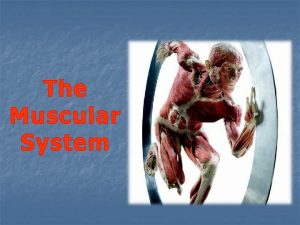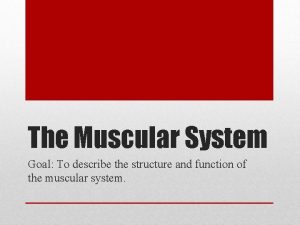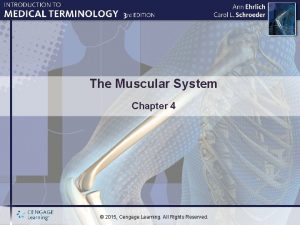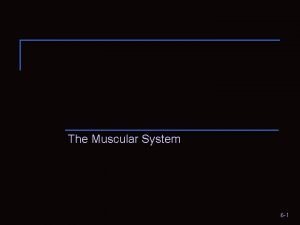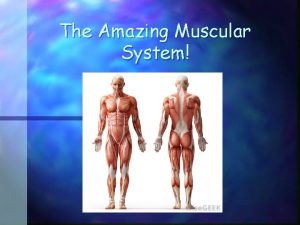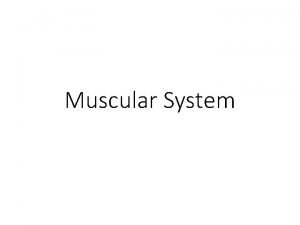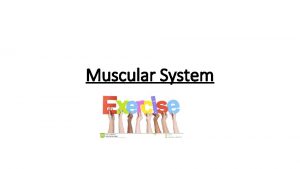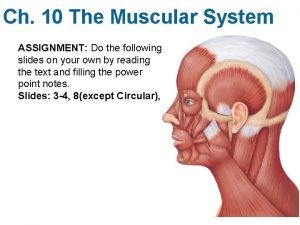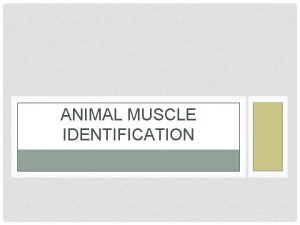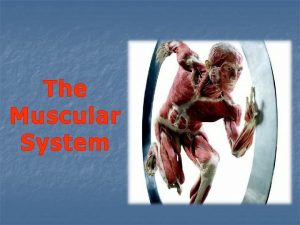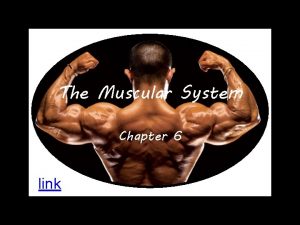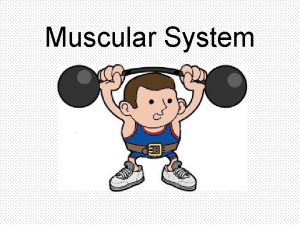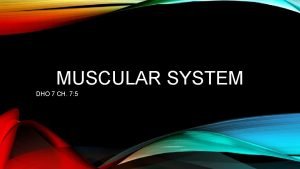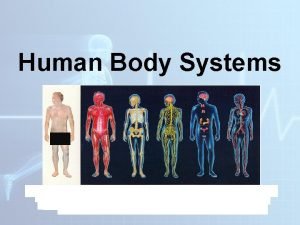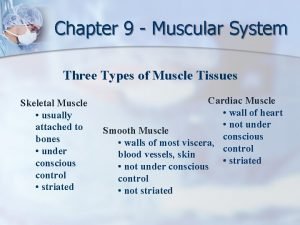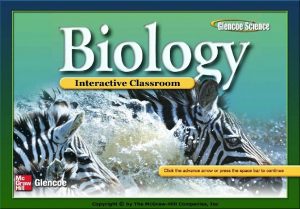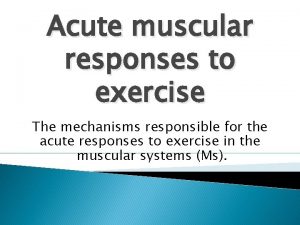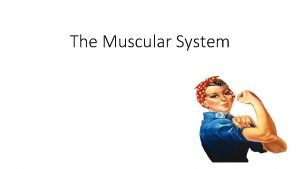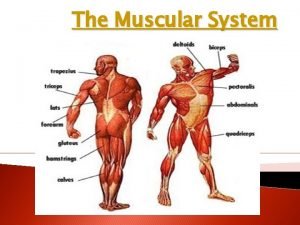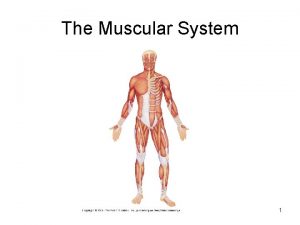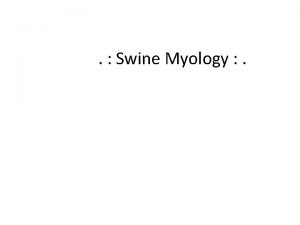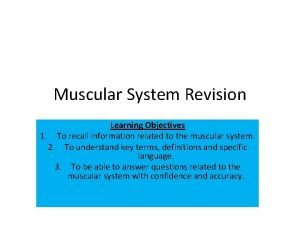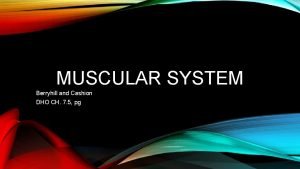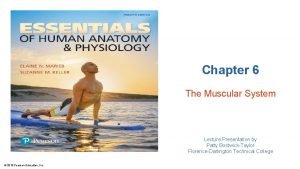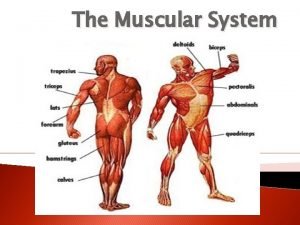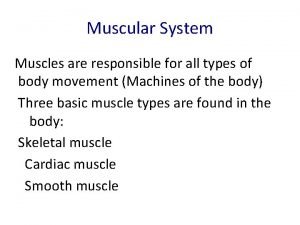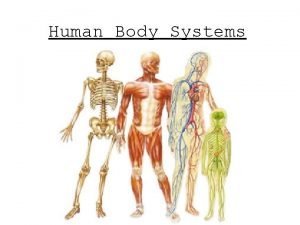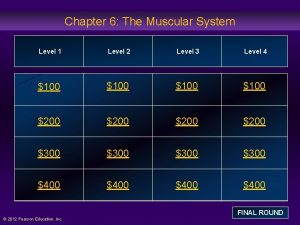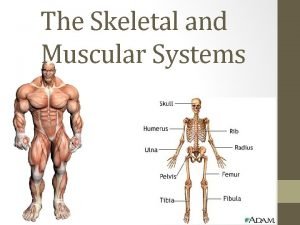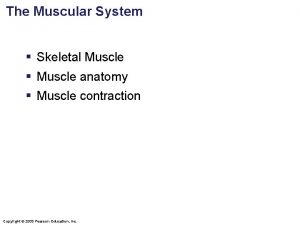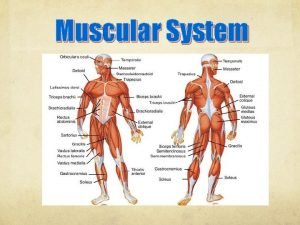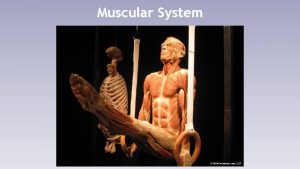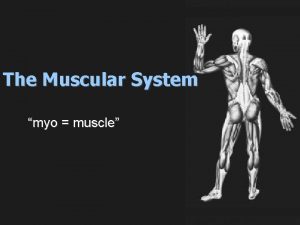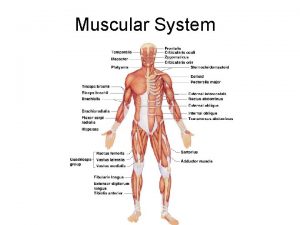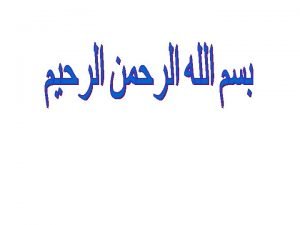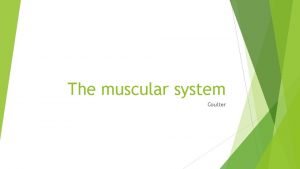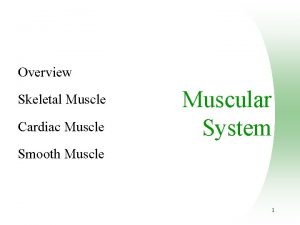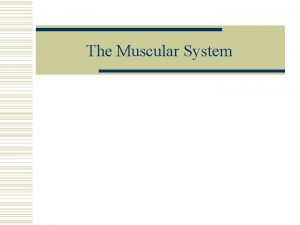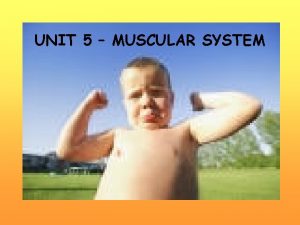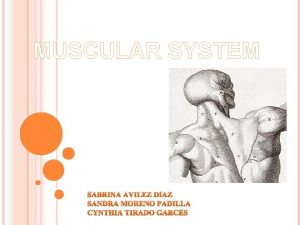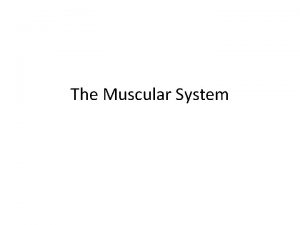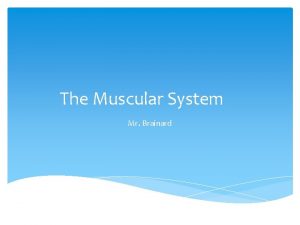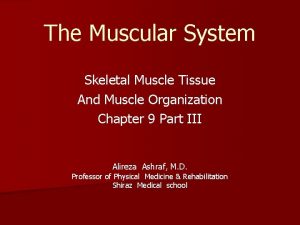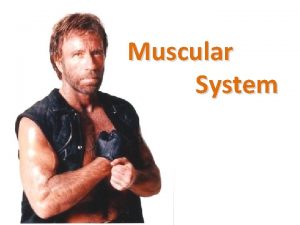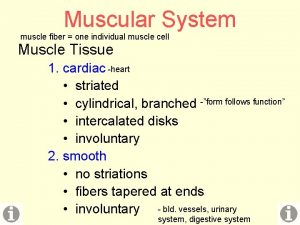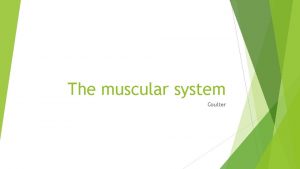5 The Muscular System Lesson 5 1 Muscle










































- Slides: 42

5 The Muscular System Lesson 5. 1: Muscle Tissue Categories and Functions Lesson 5. 2: Skeletal Muscle Actions Lesson 5. 3: The Major Skeletal Muscles Lesson 5. 4: Common Injuries and Disorders of Muscles

Chapter 5: The Muscular System Lesson 5. 1 Muscle Tissue Categories and Functions

Muscle Tissue n Categories skeletal n smooth n cardiac n n Functions behavioral properties n tension and types of skeletal muscle contractions n

Muscle Tissue Categories n skeletal voluntary n striated n n smooth involuntary n no striations n n cardiac involuntary n striated n intercalated disks n

Muscle Tissue Categories

Skeletal Muscle Organization n n Sarcolemma and endomysium surrounds the muscle fiber Perimysium bundles groups of muscle fibers to make up a fascicle Epimysium encloses several fascicles to make up a muscle Aponeurosis connects muscle to other tissues

Skeletal Muscle Organization

Behavioral Properties of Muscle extensibility–stretch n elasticity–snap back n irritability–respond n contractility–shorten n

Muscle Tissue Functions n tension and types of skeletal muscle contraction agonist–moves bone n antagonist–opposes the movement of the agonist n

Concentric Contraction n agonist contracts, antagonist relaxes

Eccentric Contraction n agonist contracts while lengthening, antagonist relaxes

Isometric Contraction n both agonist and antagonist contract

Chapter 5: The Muscular System Lesson 5. 2 Skeletal Muscle Actions

Skeletal Muscle the motor unit n skeletal fiber types n muscular strength, power, and endurance n

The Motor Unit group of muscle fibers under the control of one motor neuron n 100 -2000 fibers, depending on size and function of muscle n

Generating Action Potentials n Acetylcholine crosses the synaptic cleft at the neuromuscular junction (neurotransmitter) n Na+ rushes in, K+ rushes out->creates POSITIVE charge (Depolarization) n More Na+ enters- Action potential begins

Contraction of the Sarcomeres n Fed by glycogen (stored glucose) Triggered by Ca++ release n Sarcomeres shorten by actin filaments (heads grabbing) sliding along myosin filaments Number and frequency of action n potentials determine speed and force of contraction!

Maximum Tension and Return to Relaxation Action potential always causes entire motor unit muscle fibers to contract- then it must FULLY relax before a new stimulus can be applied n All-or-none law n Multiple motor units must be stimulated to produce maximum tension n Sustained maximum n

Skeletal Muscle Fiber Types n n Type 1 - Slow-twitch contracts relatively slowly and is resistant to fatigue Type IIa - These fast twitch muscle fibers are also known as intermediate fast-twitch fibers. Moderate fatigue Type IIb - This fast twitch muscle fiber has the highest rate of contraction (rapid firing) of all the muscle fiber types, but it also has the highest rate of fatigue. All muscle fibers in a motor unit are the same type, but not all motor

Skeletal Muscle Fiber Architecture n parallel fiber arrangements- large range of motion Fusiform- biceps brachii n Bundled- rectus abdominus n Triangular- pectoralis major n n pennate fiber arrangements. Oblique attachment gives force, Does not shorten as much n Unipennate- abductor pollux n Bipennate- rectus femoris n Multipennate-deltoid

Muscular Strength n Rotary force that muscles can produce at a joint n the maximum weight you can lift is a measurement of muscular strength ONLY (no variable for speed)

Muscle Power n force x velocity (both force and speed contribute equally, so strength is not the determining factor) n how fast you can sprint is a measurement of muscle power

Muscle Endurance n Muscle tension/time n Can be sustained or cyclical- varies based on activity n how far you can run is a measurement of muscle endurance n So is rowing n Handstands n Cycling

Fatigue Opposite of endurance n Affected by: n Nature of work/exercise done n How often the muscle is used n Muscle fiber composition n Humidity/temperature of enviornment n

Chapter 5: The Muscular System Lesson 5. 3 The Major Skeletal Muscles

The Major Skeletal Muscles directional motions n head and neck muscles n trunk muscles n upper limb muscles n lower limb muscles n

Skeletal Muscle Attachments n Origin n n fixed end of a muscle Insertion n movable end of a muscle

Sagittal Plane Movements Anterior and Posterior Flexion- forward (except knee) n Extension- back to normal position n Hyperextension- too far n Dorsiflexion- toes toward body n Plantar flexion- “gas pedal”- point toes n

Frontal Plane Movements Medial and Lateral Abduction- limb lateral n Adduction-limb medial n Inversion-foot medial n Eversion-foot lateral n radial deviationn Hand lateral at wrist n ulnar deviation. Hand medial at wrist

Transverse Plane Movements Rotational Medial rotation-toward midline n Lateral rotation- away from midline n Pronation- palm down n Supination- palm up n

Multiplanar Movements Not in a single plane Circumduction- make a circle n Opposition- thumb to any of the other 4 fingers n

Head and Neck Muscles All except orbicularis Oris and Platysma are paired

Trunk Musclesand protection Posture, stability

Upper Limb Muscles- NOT all of (just the major ones) them

Lower Limb Muscles(just the major ones)

Chapter 5: The Muscular System Lesson 5. 4 Common Injuries and Disorders of Muscles

Muscle Injuries n Strain – overstretched muscle (less common in the more flexible, speed at time of injury is a factor as well) grade I- mild: tightness 1 day n grade II- moderate: partial tear, temporary weakness and loss of function n grade III- severe: torn muscle, loss of function, internal bleeding, swelling. EX: Hamstring strains most common, n

Muscle Injuries n Contusion – bruised muscle from impact n myositis ossificans n When an already injured muscle is struck, forms calcium mass over 3 -4 weeks. Reabsorbs after 6 -7 weeks (usually) n Cramps – spasming muscle n Numerous causes: electrolyte imbalance, Ca, Mg, K deficiency, dehydration, idiopathic n Delayed onset muscle soreness – begins 24 -48 hours later, multiple, microscopic

Tendon Injuries Tendinitis – inflamed tendon n Tendinosis – degeneration of a tendon leading to rupture. No inflammation n Val Thoermer/Shutterstock. com

Joint / Stress Injuries n Rotational injury at shoulder n n Overuse of elbow- epicondylitis n n n Medial (little leaguer) tears lateral tears (tennis elbow) tears Shin splints- periosteum n n improper mechanics Tibial tendons Whiplash- abnormal motion n Cervical vertebrae, muscle spasms Attempt to protect spine

Muscle Disorders Hernia - A hernia is the protrusion of an organ or the fascia of an organ through the muscular wall of the cavity that normally contains it. n Complications include strangulation n Repair with surgery n Various causes n Heavy lifting n Increased abdominal pressure n Present at birth n

Muscle Disorders n Muscular dystrophy - a group of inherited, progressive disorders that involve muscle weakness and loss of muscle tissue, varies in severity. No cure.
 Lesson 2 muscle storyboard
Lesson 2 muscle storyboard Plyometrics disadvantages
Plyometrics disadvantages Smooth muscle fibres are fusiform and syncytial
Smooth muscle fibres are fusiform and syncytial _____ muscles run across the cheek.
_____ muscles run across the cheek. How do muscles move
How do muscles move Muscular system primary function
Muscular system primary function Function of muscles
Function of muscles Chapter 4 the muscular system learning exercises answer key
Chapter 4 the muscular system learning exercises answer key Unit 6:5 muscular system
Unit 6:5 muscular system Amazing facts about the muscular system
Amazing facts about the muscular system Epimysium vs fascia
Epimysium vs fascia Muscular system label
Muscular system label Rectus femoris fascicle arrangement
Rectus femoris fascicle arrangement Muscular system assignment
Muscular system assignment Sheep muscular system
Sheep muscular system Navigating the body movements of the body #1
Navigating the body movements of the body #1 Whats the function of the muscular system
Whats the function of the muscular system Chapter 6 the muscular system figure 6-12
Chapter 6 the muscular system figure 6-12 Whats in the muscular system
Whats in the muscular system Test chapter 7:5 muscular system
Test chapter 7:5 muscular system Chapter 9 muscular system
Chapter 9 muscular system Structures of the muscular system
Structures of the muscular system Active muscle
Active muscle Chapter 32 section 3 the muscular system
Chapter 32 section 3 the muscular system Muscular system response to exercise
Muscular system response to exercise Whats the muscular system
Whats the muscular system Muscular system diagram
Muscular system diagram Chapter 6 the muscular system figure 6-9
Chapter 6 the muscular system figure 6-9 Muscular system levels of organization
Muscular system levels of organization Superficial muscular system
Superficial muscular system Porcine myology
Porcine myology Muscular system learning objectives
Muscular system learning objectives Chapter 7:5 muscular system
Chapter 7:5 muscular system Chapter 6 the muscular system
Chapter 6 the muscular system Cengage chapter 4 answers
Cengage chapter 4 answers What are the major functions of the muscular system
What are the major functions of the muscular system I band h zone
I band h zone 3 function of the muscular system
3 function of the muscular system Musculo fusiforme
Musculo fusiforme Chapter 6 the muscular system
Chapter 6 the muscular system Chapter 6 the muscular system
Chapter 6 the muscular system Chapter 10 the muscular system
Chapter 10 the muscular system Muscles
Muscles
